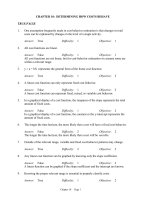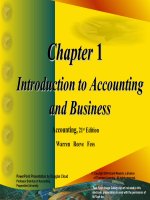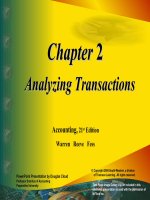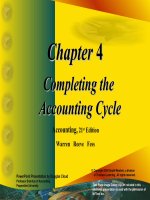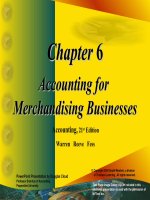Accounting 21th waren reeve fess chapter 10
Bạn đang xem bản rút gọn của tài liệu. Xem và tải ngay bản đầy đủ của tài liệu tại đây (2.51 MB, 73 trang )
Chapter 10
Fixed Assets and
Intangible Assets
Accounting, 21st Edition
Warren Reeve Fess
PowerPoint Presentation by Douglas Cloud
Professor Emeritus of Accounting
Pepperdine University
© Copyright 2004 South-Western, a division
of Thomson Learning. All rights reserved.
Task Force Image Gallery clip art included in this
electronic presentation is used with the permission of
NVTech Inc.
Some
Some of
of the
the action
action has
has been
been automated,
automated, so
so
click
click the
the mouse
mouse when
when you
you see
see this
this
lightning
lightningbolt
bolt in
in the
the lower
lower right-hand
right-hand
corner
corner of
of the
the screen.
screen. You
You can
can point
point and
and
click
click anywhere
anywhere on
on the
the screen.
screen.
Objectives
Objectives
1. Define fixed assets and describe the accounting
for their cost.After studying this
After
studying
this
2. Compute depreciation, using the following
chapter,
should
chapter, you
you
should
methods: straight-line
method,
units-ofproduction method,
declining-balance
be
able
to:
beand
able
to:
method.
3. Classify fixed asset costs as either capital
expenditures or revenue expenditures.
4. Journalize entries for the disposal of fixed assets.
5. Define a lease and summarize the accounting
rules related to the leasing of fixed assets.
Objectives
Objectives
6. Describe internal controls over fixed assets.
7. Compute depletion and journalize the entry for
depletion.
8. Describe the accounting for intangible assets,
such as patents, copyrights, and goodwill.
9. Describe how depreciation expense is
reported in an income statement, and prepare
a balance sheet that includes fixed assets and
intangible assets.
10. Compute and interpret the ratio of fixed assets
to long-term debt.
Nature
Nature of
of Fixed
Fixed Assets
Assets
Fixed
Fixed assets
assets are
are long
long term
term or
or
relatively
relatively permanent
permanent assets
assets
Fixed
Fixed assets
assets are
are tangible
tangible assets
assets
because
because they
they exist
exist physically.
physically.
They
They are
are owned
owned and
and used
used by
by the
the
business
business and
and are
are not
not held
held for
for sale
sale
as
as part
part of
of normal
normal operations.
operations.
Classifying
Classifying Costs
Costs
Is the purchased
item long-lived?
Yes
No
Is the asset used in
a productive
purpose?
Yes
No
Fixed Assets
Expense
Investment
Land
Land
••
••
••
••
••
••
Purchase
Purchase price
price
Sales
Sales taxes
taxes
Permits
Permits from
from government
government
agencies
agencies
Broker’s
Broker’s commissions
commissions
Title
Title fees
fees
Surveying
Surveying fees
fees
Land
Land
••
••
••
••
••
••
Purchase
Purchase price
price
•• Delinquent
real
estate
taxes
Delinquent
real
estate
taxes
Sales
taxes
Sales taxes
•• from
Razing
or
Razing
or removing
removing
Permits
government
Permits from
government
unwanted buildings,
buildings, less
lessthe
the
agencies
agenciesunwanted
salvage
salvage
Broker’s
Broker’scommissions
commissions
•• Grading
and
leveling
Grading
and
leveling
Title
fees
Title fees
•• Paving
aa public
street
Paving
public
street
Surveying
fees
Surveying fees
bordering
bordering the
the land
land
Buildings
Buildings
Architects’ fees
Engineers’ fees
Insurance costs incurred
during construction
Interest on money
borrowed to finance
construction
Walkways to and
around the building
Buildings
Buildings
Sales taxes
Repairs (purchase of
existing building)
Reconditioning
(purchase of an existing
building)
Modifying for use
Permits from
governmental agencies
Land Improvements
•
•
•
•
•
•
Trees and shrubs
Fences
Parking areas
Outdoor lighting
Concrete sewers and drainage
Paved parking areas
Machinery
Machinery and
and Equipment
Equipment
•
•
•
•
Sales taxes
Freight
Installation
Repairs (purchase of used
equipment)
• Reconditioning (purchase
of used equipment)
Machinery
Machinery and
and Equipment
Equipment
•
•
•
•
•
Insurance while in transit
Assembly
Modifying for use
Testing for use
Permits from
governmental agencies
Cost
Cost of
of Acquiring
Acquiring Fixed
Fixed Assets
Assets Excludes:
Excludes:
Vandalism
Mistakes in installation
Uninsured theft
Damage during unpacking and installing
Fines for not obtaining proper permits from
government agencies
Nature
Nature of
of Depreciation
Depreciation
All
All fixed
fixed assets
assets except
except land
land lose
lose their
their capacity
capacity
to
to provide
provide services.
services. This
This loss
loss of
of productive
productive
capacity
capacity isis recognized
recognized as
as Depreciation
Depreciation Expense.
Expense.
Physical
Physical depreciation
depreciation occurs
occurs from
from wear
wear and
and tear
tear
while
while in
in use
use and
and from
from the
the action
action of
of the
the weather.
weather.
Functional
Functional depreciation
depreciation occurs
occurs when
when aa fixed
fixed asset
asset
isis longer
longer able
able to
to provide
provide services
services at
at the
the level
level for
for
which
which itit was
was intended,
intended, e.g.,
e.g., personal
personal computer.
computer.
Depreciation
Depreciation Expense
Expense Factors
Factors
Initial Cost
-
Residual Value
=
Depreciable Cost
Useful Life
1
2
3
4
5
Periodic Depreciation
Expense
Use
Use of
of Depreciation
Depreciation Methods
Methods
Other Units-of-Production
5%
Declining4%
Balance
8%
83%
Straight-Line
Source: Accounting Trends & Techniques, 56th. ed., American Institute of
Certified Public Accountants, New York, 2002.
Facts
Facts
Original
Original Cost.....…………..
Cost.....………….. $24,000
$24,000
Estimated
55 years
Estimated Life
Life in
in years…..
years…..
years
Estimated
10,000
Estimated Life
Life in
in hours…..
hours…..
10,000
Estimated
Estimated Residual
Residual Value...
Value...
$2,000
$2,000
Straight-Line
Straight-Line Method
Method
Cost – estimated residual value
Estimated life
= Annual depreciation
Straight-Line
Straight-Line Method
Method
$24,000 – $2,000
5 years
= $4,400 annual depreciation
Straight-Line
Straight-Line Rate
Rate
$24,000 – $2,000
= $4,400
5 years
$4,400
= 18.3%
$24,000
Straight-Line
Straight-Line Method
Method
The
The straight-line
straight-line method
method isis widely
widely used
used
by
by firms
firms because
because itit isis simple
simple and
and itit
provides
provides aa reasonable
reasonable transfer
transfer of
of cost
cost to
to
periodic
periodic expenses
expenses ifif the
the asset
asset isis used
used
about
about the
the same
same from
from period
period to
to period.
period.
Straight-Line
Straight-Line Method
Method
Year
Cost
1
2
3
4
5
$24,000
24,000
24,000
24,000
24,000
Accum. Depr.
at Beginning
of Year
$ 4,400
8,800
13,200
17,600
Book Value
at Beginning
of Year
$24,000
19,600
15,200
10,800
6,400
Depr.
Expense
for Year
Book Value
at End
of Year
$4,400
4,400
4,400
4,400
4,400
$19,600
15,200
10,800
6,400
2,000
Cost ($24,000) – Residual Value ($2,000)
Estimated Useful Life (5 years)
Annual
= Depreciation
Expense ($4,400)
Units-of-Production
Units-of-Production Method
Method
Cost – estimated residual value
Estimated life in units, hours, etc.
= Depreciation per unit, hour, etc.
